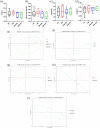Aerobic exercise alleviates cognitive impairment in T2DM mice through gut microbiota
- PMID: 40615512
- PMCID: PMC12227742
- DOI: 10.1038/s41598-025-07220-1
Aerobic exercise alleviates cognitive impairment in T2DM mice through gut microbiota
Abstract
The risk of cognitive impairment is markedly elevated in patients with type 2 diabetes mellitus (T2DM). While exercise has been shown to mitigate cognitive deficits associated with diabetes, the underlying mechanisms remain poorly understood. Recent studies suggest that exercise can modulate the composition of the gut microbiota, which, in turn, may influence the central nervous system via the microbiota-gut-brain axis. However, the specific role of gut microbiota in mediating exercise-induced improvements in cognitive function in T2DM remains unclear. In this study, we aimed to investigate whether exercise can alleviate cognitive impairment in T2DM mice by modulating the intestinal microbiota, and to elucidate the mechanisms underlying this effect. This study was conducted using male C57BL/6J mice. Mice fed a normal diet were assigned to the non-diabetic control group (NC), while those fed a high-fat diet were intraperitoneally injected with streptozotocin (STZ) and subsequently divided into the diabetic control group (DM), an exercise group (DM-EXE), and a fecal microbiota transplantation group (DM-FMT). The DM-EXE group underwent treadmill exercise for 8 weeks. During this period, the DM-FMT group received fecal microbiota transplants from the DM-EXE group for 2 consecutive days per week. Following the 8-week intervention, stool samples were collected for 16S rDNA high-throughput sequencing. The fear conditioning test was performed to assess cognitive function. Intestinal mucosa samples were collected to evaluate the expression of intestinal tight junction proteins. Additionally, the expression levels of synaptic proteins, glucose transporters, neurotrophic factors, and inflammatory markers were measured in the hippocampus. Our findings demonstrate that T2DM mice exhibit impaired cognitive function and significant alterations in their gut microbiota compared to non-diabetic controls. Exercise partially reversed these changes in the intestinal microbiota and alleviated cognitive impairment in T2DM mice. Additionally, transplantation of intestinal microbiota from exercised mice improved cognitive function in T2DM mice. Aerobic exercise may mitigate cognitive impairment in T2DM mice by modulating the gut microbiota. The underlying mechanisms appear to involve enhanced neural synaptic plasticity, reduced neuroinflammation, and improved neuronal glucose metabolism.
Keywords: Cognitive; Exercise; Microbiota; Type 2 diabetes mellitus.
© 2025. The Author(s).
Conflict of interest statement
Declarations. Competing interests: The authors declare no competing interests. Ethics approval and consent to participate: All animal experiments were approved by the Animal Ethics Committee of The Second People’s Hospital of Changzhou.
Figures







Similar articles
-
Animal studies on the modulation of differential efficacy of polyethylene glycol loxenatide by intestinal flora.Front Endocrinol (Lausanne). 2025 Jun 19;16:1508473. doi: 10.3389/fendo.2025.1508473. eCollection 2025. Front Endocrinol (Lausanne). 2025. PMID: 40612440 Free PMC article.
-
Intestinal inflammation and microbiota modulation impact cochlear function: emerging insights in gut-ear axis.Cell Commun Signal. 2025 Jul 26;23(1):357. doi: 10.1186/s12964-025-02338-1. Cell Commun Signal. 2025. PMID: 40713718 Free PMC article.
-
Transplant of fecal microbiota from healthy young mice relieves cognitive defects in late-stage diabetic mice by reducing metabolic disorders and neuroinflammation.Acta Pharmacol Sin. 2024 Dec;45(12):2513-2526. doi: 10.1038/s41401-024-01340-6. Epub 2024 Jul 11. Acta Pharmacol Sin. 2024. PMID: 38992120
-
Diet, physical activity or both for prevention or delay of type 2 diabetes mellitus and its associated complications in people at increased risk of developing type 2 diabetes mellitus.Cochrane Database Syst Rev. 2017 Dec 4;12(12):CD003054. doi: 10.1002/14651858.CD003054.pub4. Cochrane Database Syst Rev. 2017. PMID: 29205264 Free PMC article.
-
Fecal microbiota transplantation for the treatment of recurrent Clostridioides difficile (Clostridium difficile).Cochrane Database Syst Rev. 2023 Apr 25;4(4):CD013871. doi: 10.1002/14651858.CD013871.pub2. Cochrane Database Syst Rev. 2023. PMID: 37096495 Free PMC article.
References
-
- Cho, N. H. et al. IDF diabetes atlas: Global estimates of diabetes prevalence for 2017 and projections for 2045. Diabetes Res. Clin. Pract.138, 271–281 (2018). - PubMed
-
- Schnaider Beeri, M. et al. Diabetes mellitus in midlife and the risk of dementia 3 decades later. Neurology63(10), 1902–1907 (2004). - PubMed
MeSH terms
LinkOut - more resources
Full Text Sources
Medical

